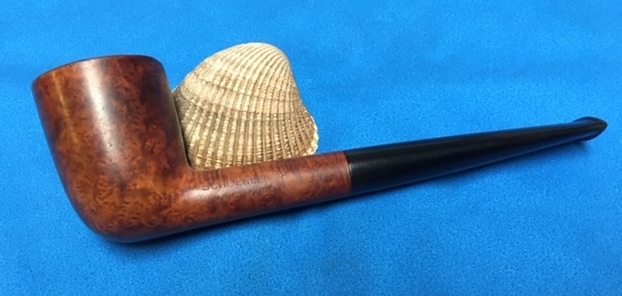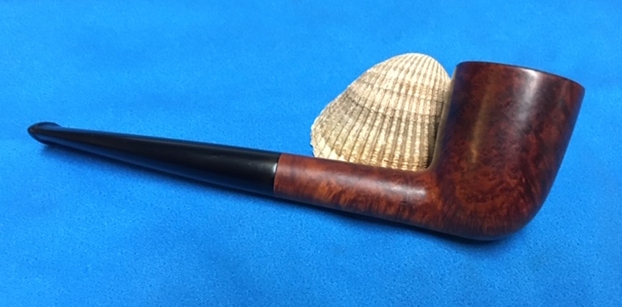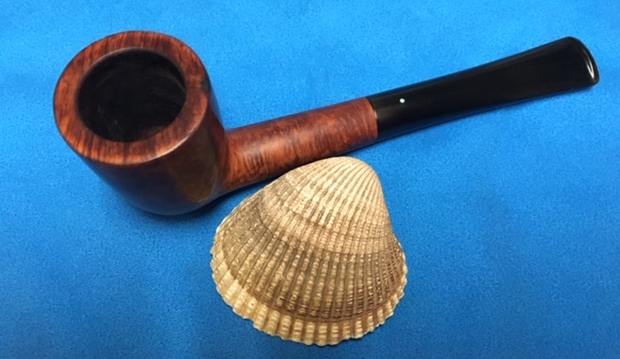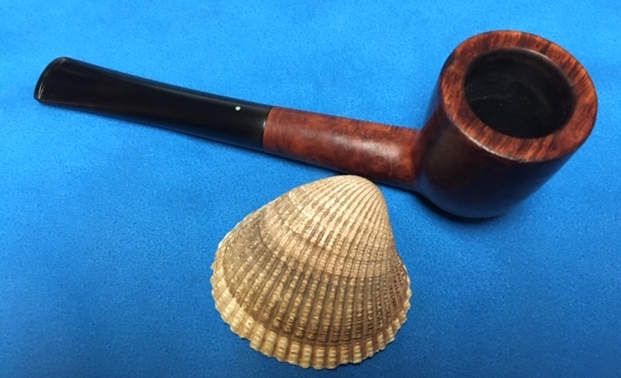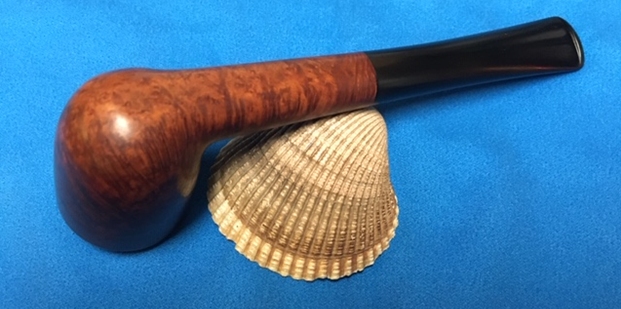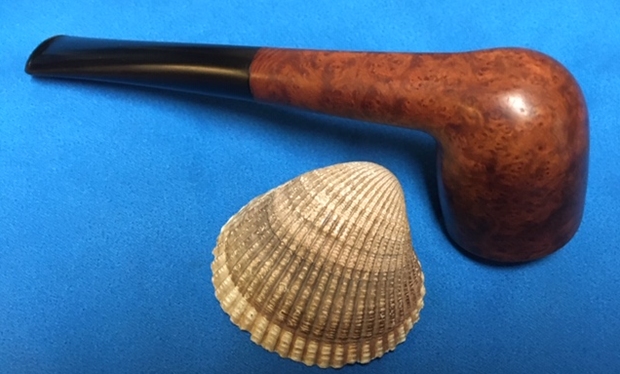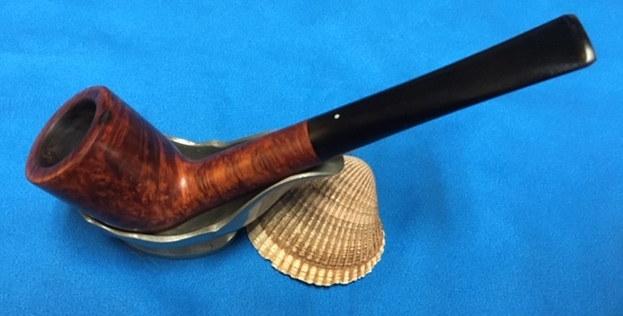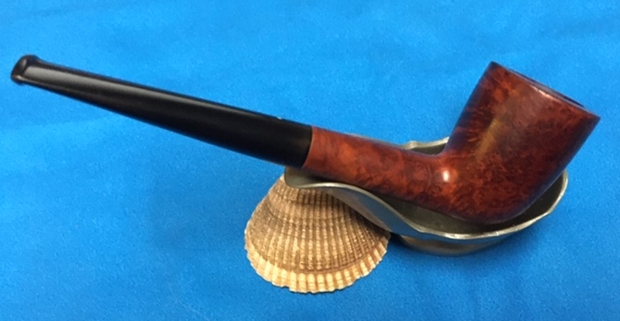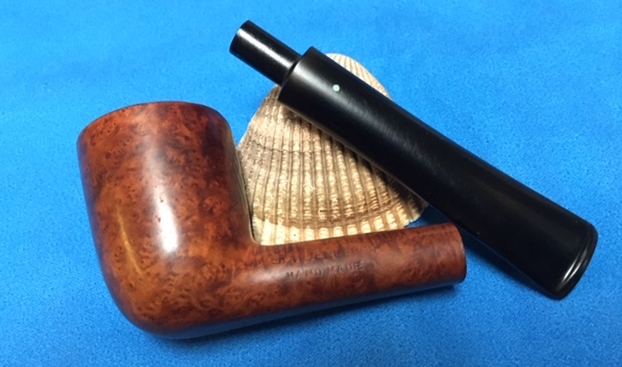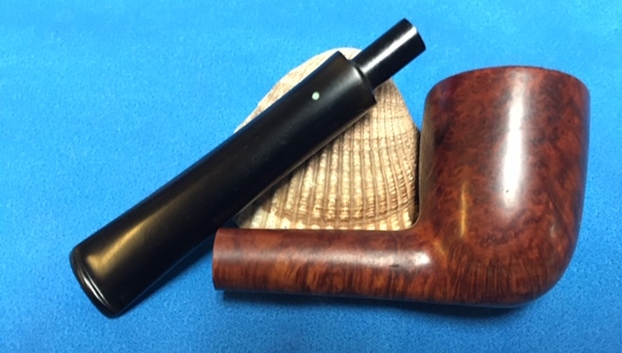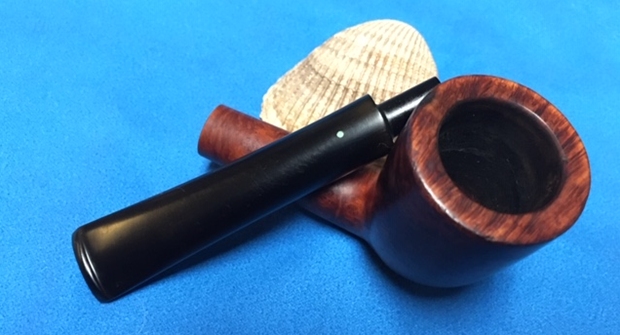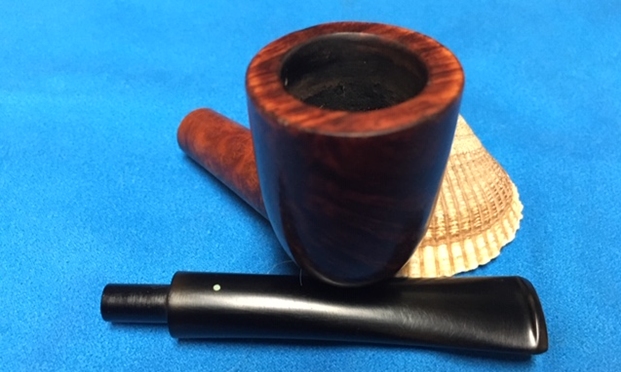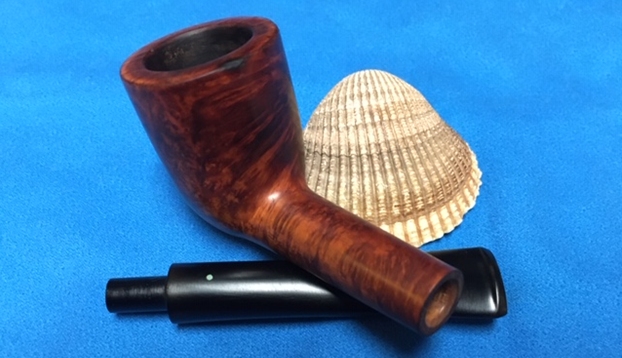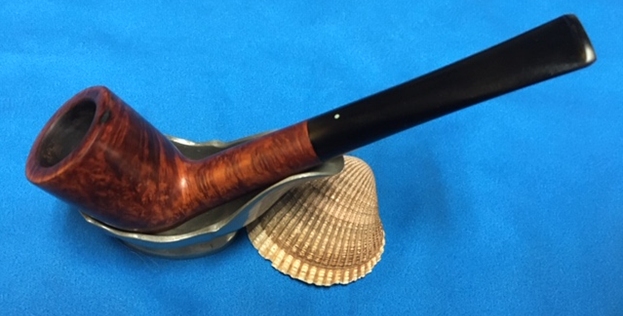Blog by Steve Laug
The next pipe in the queue is another pipe from the batch of pipes I am cleaning up for Alex – this one is another Schoenleber Hand Made – a straight shank Dublin with some beautiful grain around what appears to be an oil cured bowl and shank. The entire pipe has some beautiful mixed birdseye, cross and swirled grain around the bowl and shank. But it is under a thick coat of oils, grime and dirt. The carver did a great job utilizing the block of briar to maximize the grain. The pipe is stamped on the left side of the shank. It reads Schoenleber over Hand Made. On the right side of the shank it is stamped with a number 5 which is either a shape number or size designation. The tapered stem is vulcanite and has a single small blue dot on the top side. I think that this will be another nice looking piece much like many of the pipes Alex is picking up. The bowl is thickly caked with a thick overflow of lava on the rim top. There appears to be some damage on the inner edge but it is hard to know for sure. The exterior of the briar was dirty with grime and dust. The stem is actually quite free of tooth marks but there is tooth chatter on both sides. It is heavily oxidized and has some calcification. The photos below tell the story and give a glimpse of the pipe before clean up.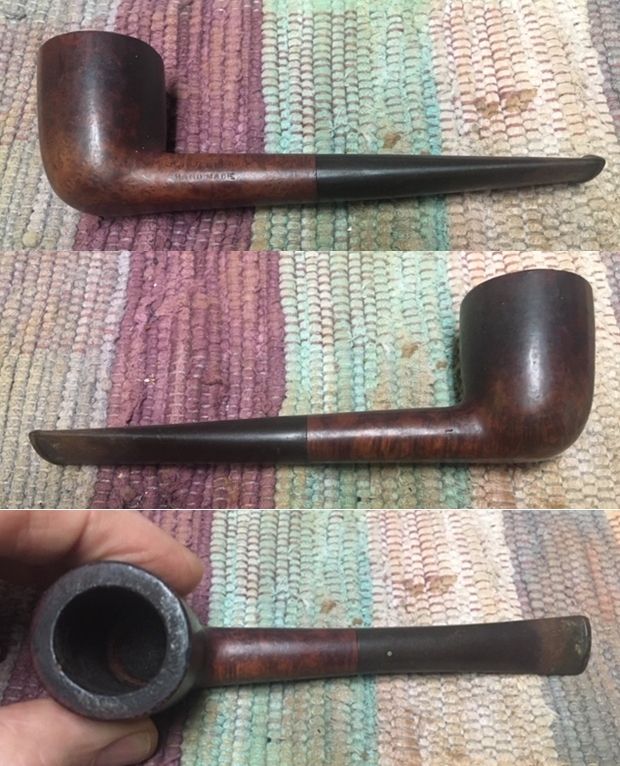 I took a photo of the bowl and rim to capture the condition of the pipe before I started my cleanup work. There was a thick cake in the bowl and a thick overflow of lava on the rim top. It was hard to know the condition of the edges of the bowl because of the lava though there appeared to be some damage to the inner edge. The stem was in decent condition. There was also some tooth chatter, oxidation and calcification on the stem surfaces.
I took a photo of the bowl and rim to capture the condition of the pipe before I started my cleanup work. There was a thick cake in the bowl and a thick overflow of lava on the rim top. It was hard to know the condition of the edges of the bowl because of the lava though there appeared to be some damage to the inner edge. The stem was in decent condition. There was also some tooth chatter, oxidation and calcification on the stem surfaces.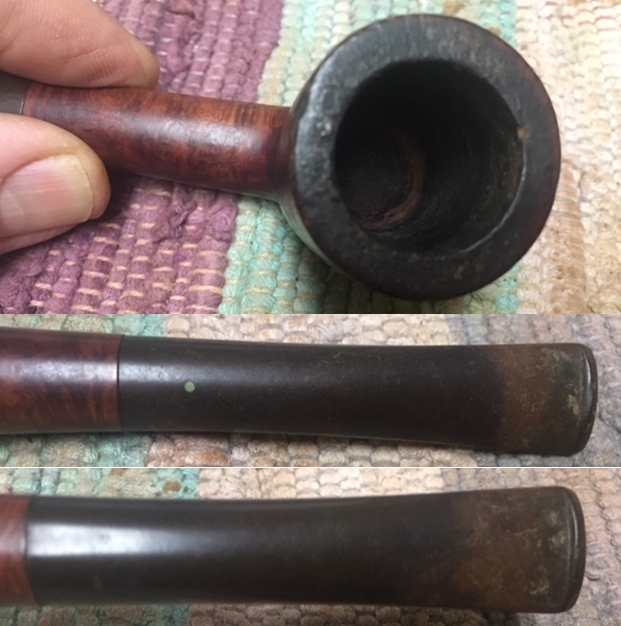 I also took a photo of right side of the shank to show the stamping. The stamping is readable in the photo below and is as noted above – Schoenleber Hand Made. On the opposite side it reads 5 at the shank/bowl junction on the right side.
I also took a photo of right side of the shank to show the stamping. The stamping is readable in the photo below and is as noted above – Schoenleber Hand Made. On the opposite side it reads 5 at the shank/bowl junction on the right side.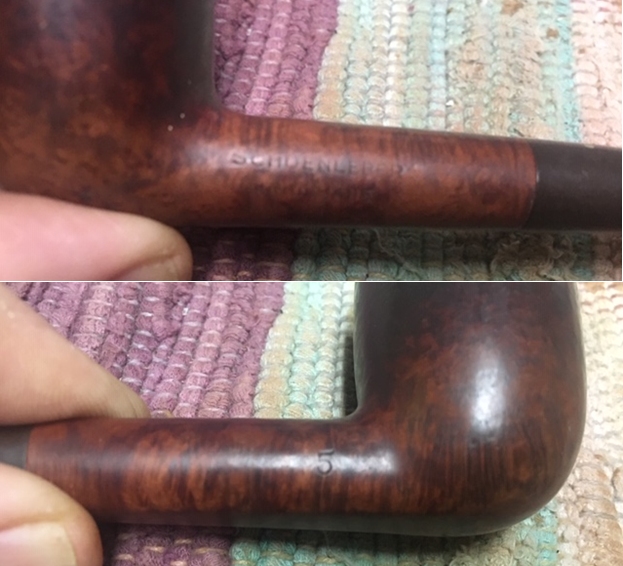 When I worked on a Schoenleber pipe for Alex in the past I had done the research on the brand. I knew that the pipe had been made for a shop in New Jersey but went back and reread the previous blog I had written on the brand. I have included the information from Pipedia that I included before. I quote the article in full (https://pipedia.org/wiki/Schoenleber).
When I worked on a Schoenleber pipe for Alex in the past I had done the research on the brand. I knew that the pipe had been made for a shop in New Jersey but went back and reread the previous blog I had written on the brand. I have included the information from Pipedia that I included before. I quote the article in full (https://pipedia.org/wiki/Schoenleber).
Louis Schoenleber lived in North Arlington N.J. and was an Austrian immigrant and skilled artisan in pipe making. His hand carved pipes were available in his shop, ‘Schoenleber’s Newark Pipe Shop’, at 26 Branford Pl., Newark NJ, thought to open in the 1920’s. Schoenleber’s carried a full line of tobaccos as well as related pipe smoking accessories. It’s thought the shop operated until the late 1960’s, and Louis Schoenleber died in 1976. It’s also fairly certain they may have sold to other brands such as Jelling, also in Newark and are very similar in design and finish.
There was also an advertising card on the site that I have included below. It speaks to my assumptions about the curing process and the finishing process on the pipe. It also connects the pipe to Schoenleber’s Newark Pipe Shop in Newark, N.J. It also has a comment on the fact that pipes were made to order. I started the restoration by working on reaming the thick cake from the bowl. I used a PipNet pipe reamer with the third cutting head to take the cake out of the bowl. It was crumbly and uneven so that was necessary. I followed up by scraping out the remaining cake with a Savinelli Fitsall Pipe Knife and finally sanded the bowl walls with 220 grit sand paper wrapped around a piece of dowel. I used the sharp edge of the Fitsall knife to scrape away the thick lava coat from the rim top.
I started the restoration by working on reaming the thick cake from the bowl. I used a PipNet pipe reamer with the third cutting head to take the cake out of the bowl. It was crumbly and uneven so that was necessary. I followed up by scraping out the remaining cake with a Savinelli Fitsall Pipe Knife and finally sanded the bowl walls with 220 grit sand paper wrapped around a piece of dowel. I used the sharp edge of the Fitsall knife to scrape away the thick lava coat from the rim top.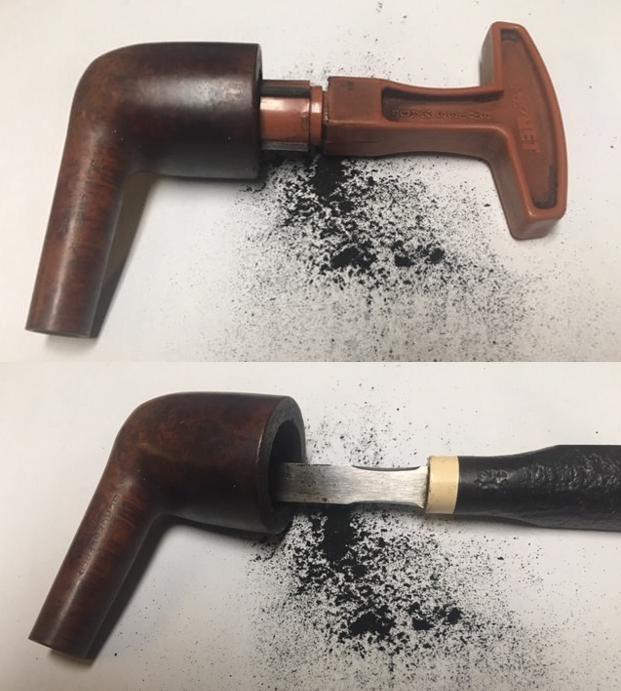
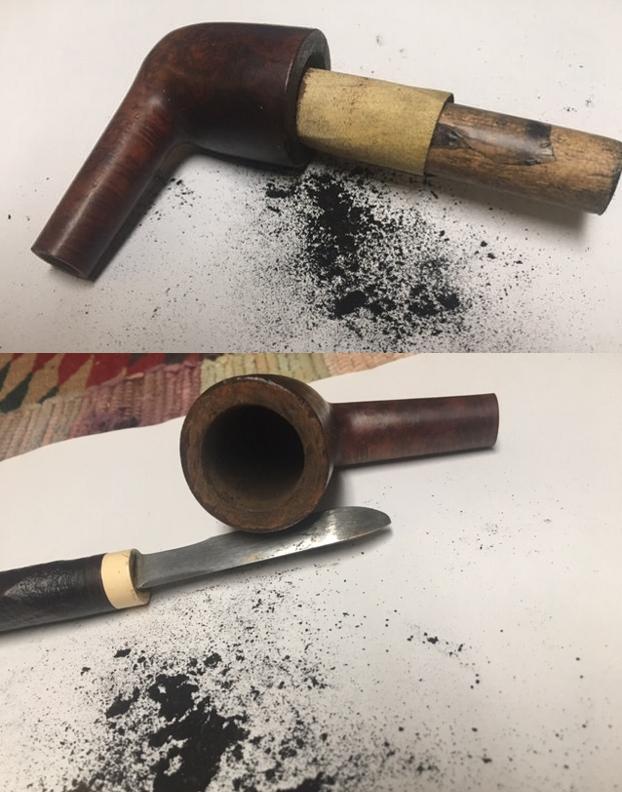 With the bowl reamed and the rim top scraped clean it was time to scrub the grime and oils off the outside of the bowl. I used undiluted Murphy’s Oil Soap and a tooth brush to scrub the briar. I rinsed off the grime that the soap removes with warm running water. I dried it off with a cotton cloth and took photos of the pipe at this point.
With the bowl reamed and the rim top scraped clean it was time to scrub the grime and oils off the outside of the bowl. I used undiluted Murphy’s Oil Soap and a tooth brush to scrub the briar. I rinsed off the grime that the soap removes with warm running water. I dried it off with a cotton cloth and took photos of the pipe at this point.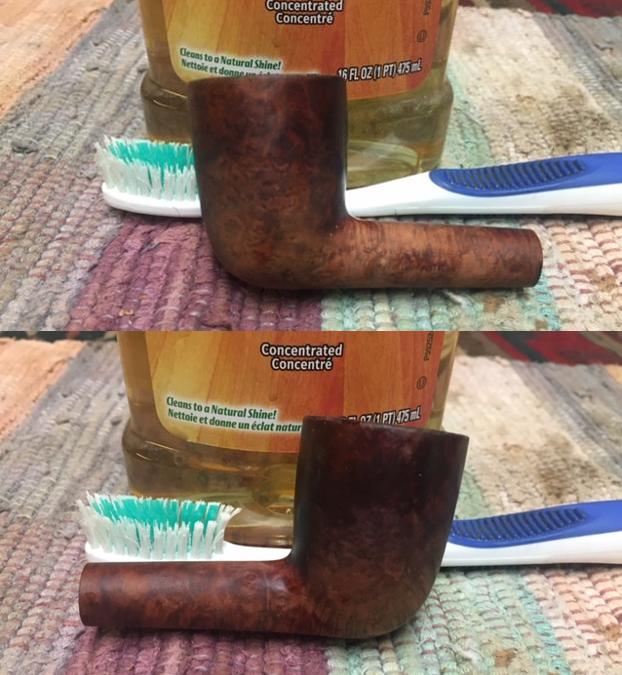
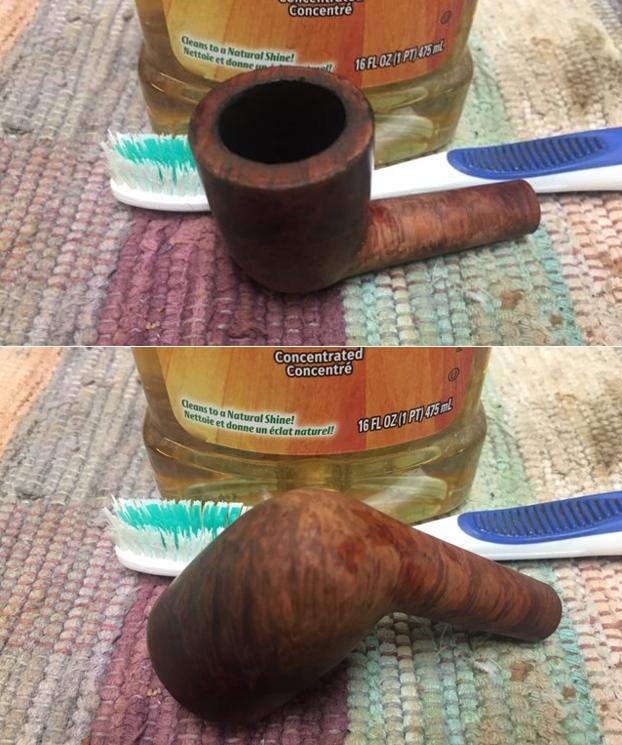 With the externals clean it was time to clean out the internals. I scraped the inside of the mortise walls with a pen knife to remove the thick tarry buildup. I scrubbed the mortise and airway in the shank and stem with pipe cleaners, cotton swabs and alcohol until they were clean.
With the externals clean it was time to clean out the internals. I scraped the inside of the mortise walls with a pen knife to remove the thick tarry buildup. I scrubbed the mortise and airway in the shank and stem with pipe cleaners, cotton swabs and alcohol until they were clean.
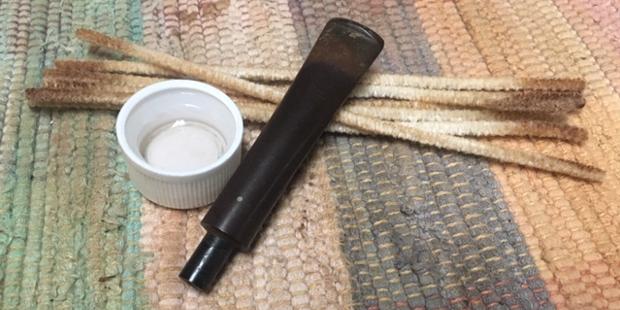 I cleaned up the damages to the inner edge of the rim with a folded piece of 220 grit sandpaper. When I finished the rim was once again clean and round.
I cleaned up the damages to the inner edge of the rim with a folded piece of 220 grit sandpaper. When I finished the rim was once again clean and round.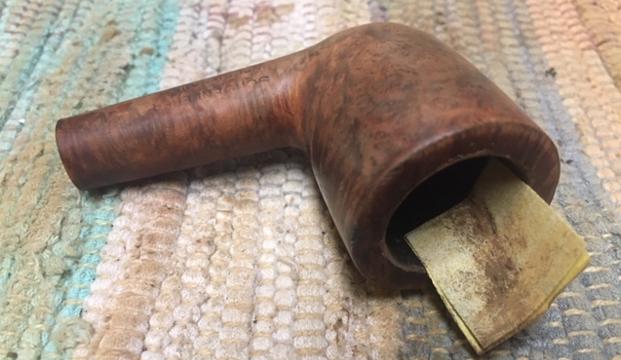 I turned to polishing the bowl and rim with micromesh sanding pads – wet sanding with 1500-12000 grit pads. I wiped the bowl down with a damp cloth after each pad to remove the sanding debris.
I turned to polishing the bowl and rim with micromesh sanding pads – wet sanding with 1500-12000 grit pads. I wiped the bowl down with a damp cloth after each pad to remove the sanding debris.


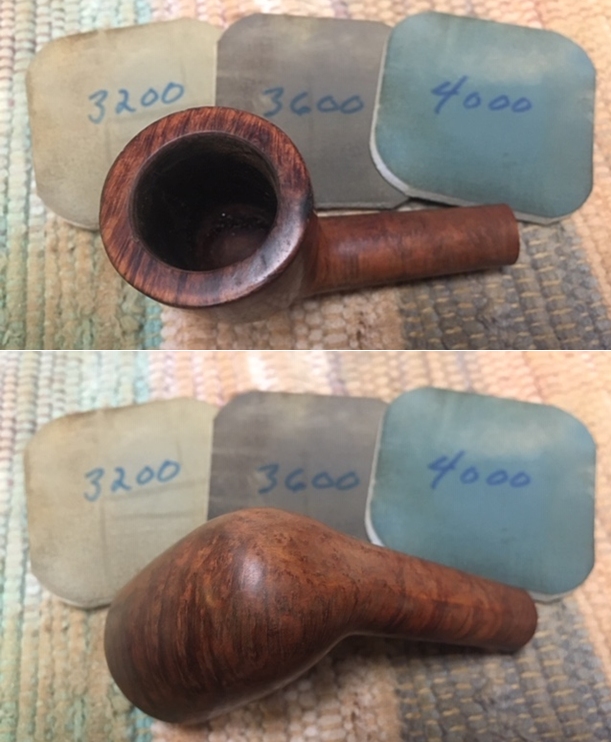
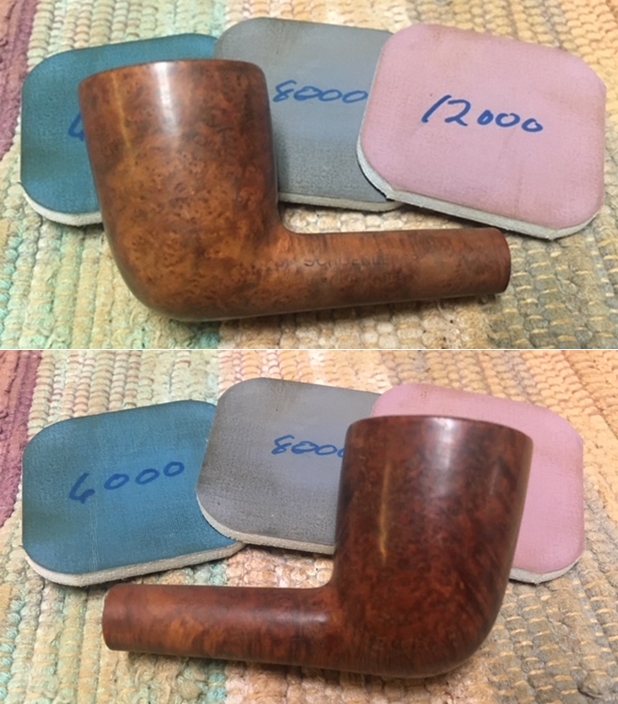
 I worked some Before & After Restoration Balm into the surface of the briar with my fingertips to clean, enliven and protect it. I let the balm sit for a little while and then buffed with a cotton cloth to raise the shine.
I worked some Before & After Restoration Balm into the surface of the briar with my fingertips to clean, enliven and protect it. I let the balm sit for a little while and then buffed with a cotton cloth to raise the shine.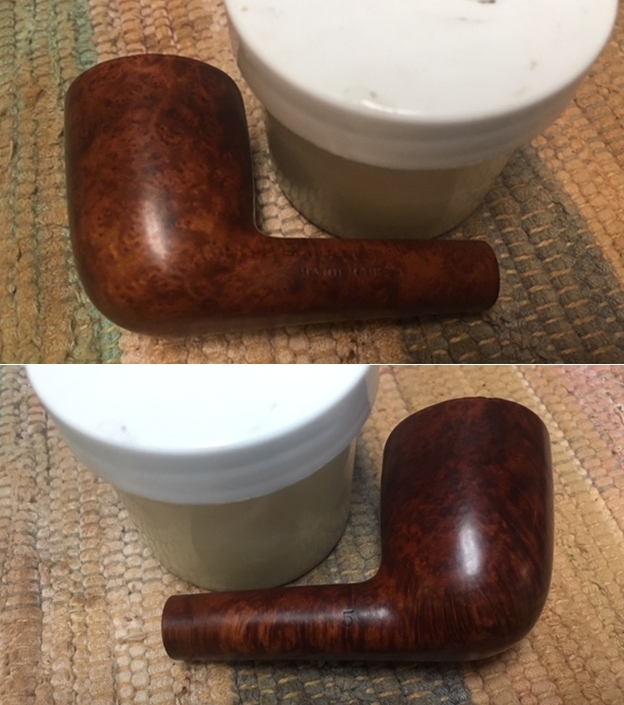

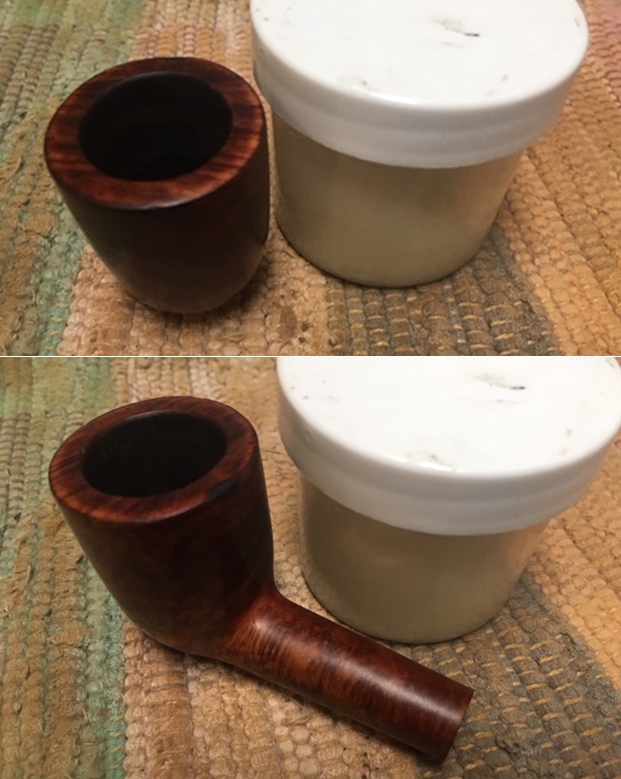 I set the bowl aside and turned my attention to the stem. I sanded it with 220 grit sandpaper to remove the oxidation and tooth chatter on both sides of the stem. I started the polishing of the surface with 400 grit wet dry sandpaper.
I set the bowl aside and turned my attention to the stem. I sanded it with 220 grit sandpaper to remove the oxidation and tooth chatter on both sides of the stem. I started the polishing of the surface with 400 grit wet dry sandpaper. 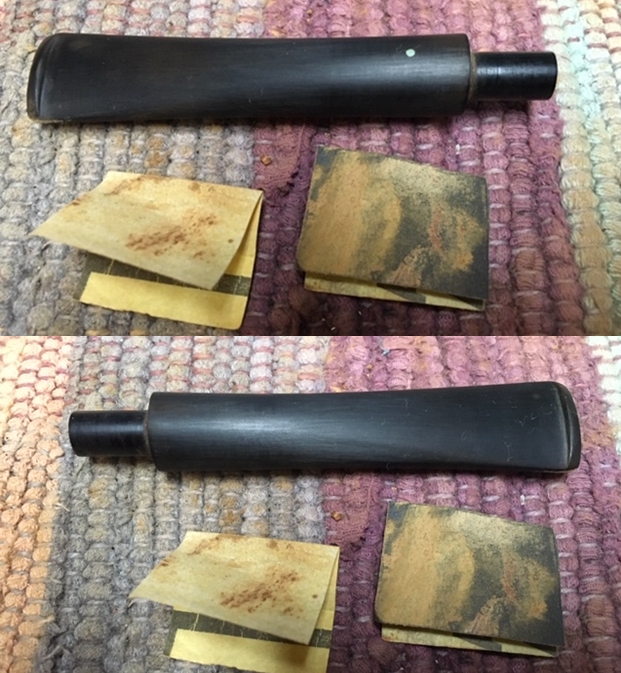 I polished the stem with micromesh sanding pads – wet sanding it with 1500-12000 grit pads. I wiped the stem down with a damp cloth after each pad. I further polished it with Before & After Pipe Polish – both Fine and Extra Fine. I wiped it down with a coat of Briarville’s No Oxy Oil and set it aside to dry.
I polished the stem with micromesh sanding pads – wet sanding it with 1500-12000 grit pads. I wiped the stem down with a damp cloth after each pad. I further polished it with Before & After Pipe Polish – both Fine and Extra Fine. I wiped it down with a coat of Briarville’s No Oxy Oil and set it aside to dry.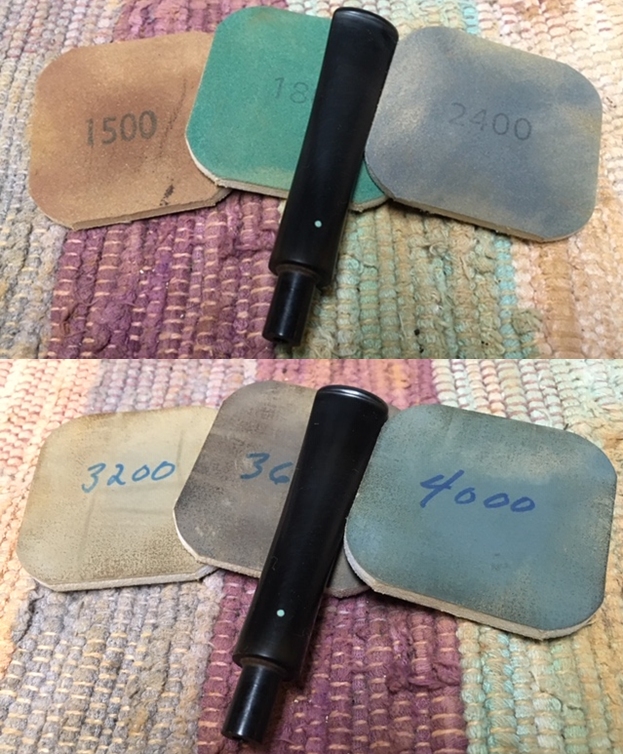
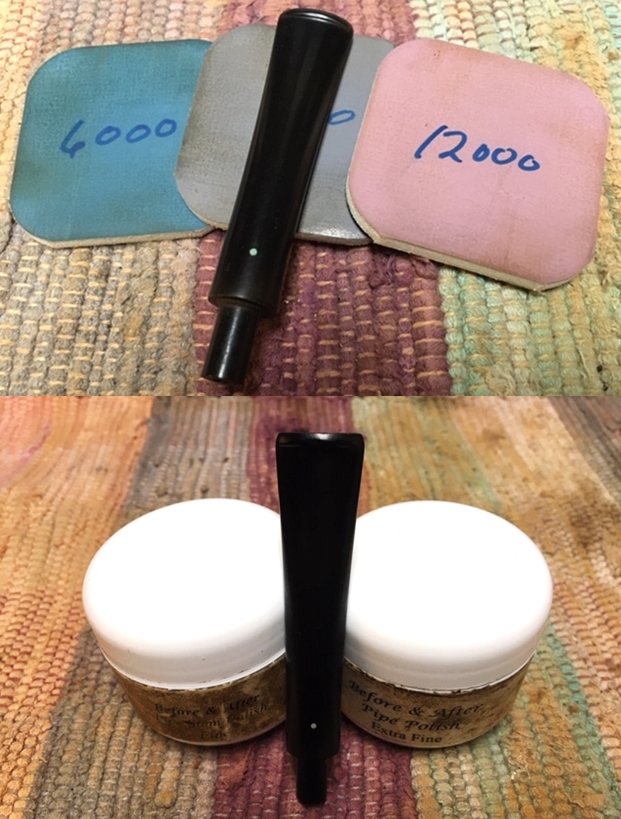
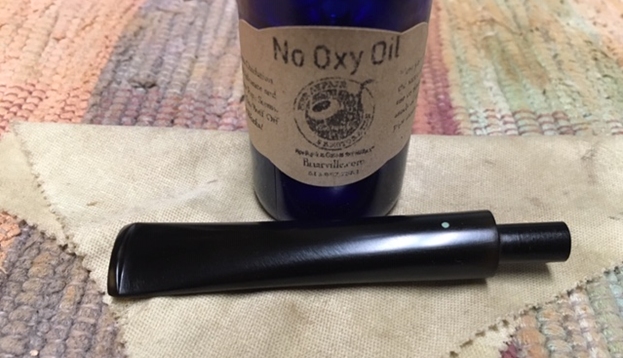 With both parts of the pipe finished, I polished the bowl and the stem with Blue Diamond polish on the buffing wheel. I gave the bowl and the stem multiple coats of carnauba wax. I buffed the pipe with a clean buffing pad to raise the shine. I hand buffed it with a microfiber cloth to deepen the shine. The pipe polished up pretty nicely. The rich oil cured finish and the grain came alive with the buffing. The finish on the briar works well with the polished black vulcanite stem. The finished pipe is a well-proportioned, nicely grained Dublin. Have a look at it with the photos below. The dimensions are Length: 5 1/2 inches, Height: 1 7/8 inches, Outside diameter of the bowl: 1 1/4 inches, Chamber diameter: 3/4 of an inch. This Schoenleber Hand Made Dublin will be going back to Alex soon to join his growing collection of American made pipes. Thanks for walking through the restoration with me on another of Alex’s pipes.
With both parts of the pipe finished, I polished the bowl and the stem with Blue Diamond polish on the buffing wheel. I gave the bowl and the stem multiple coats of carnauba wax. I buffed the pipe with a clean buffing pad to raise the shine. I hand buffed it with a microfiber cloth to deepen the shine. The pipe polished up pretty nicely. The rich oil cured finish and the grain came alive with the buffing. The finish on the briar works well with the polished black vulcanite stem. The finished pipe is a well-proportioned, nicely grained Dublin. Have a look at it with the photos below. The dimensions are Length: 5 1/2 inches, Height: 1 7/8 inches, Outside diameter of the bowl: 1 1/4 inches, Chamber diameter: 3/4 of an inch. This Schoenleber Hand Made Dublin will be going back to Alex soon to join his growing collection of American made pipes. Thanks for walking through the restoration with me on another of Alex’s pipes. 